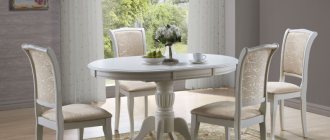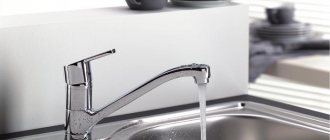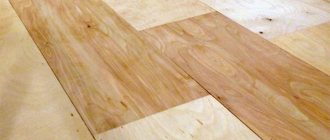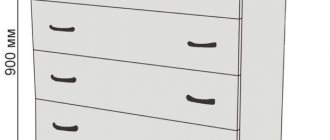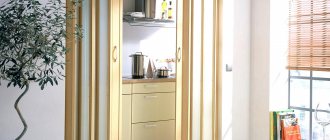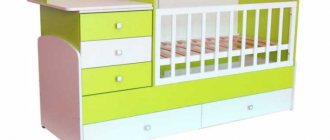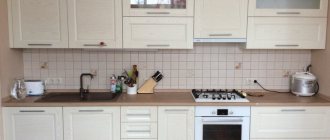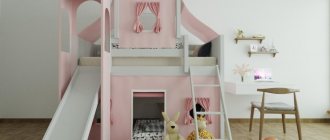The variety of floor coverings that have appeared on the building materials market in recent years has not been able to move linoleum from the pedestal of the most popular. It fits seamlessly into the interior of any room, including bedrooms, kitchens and children's rooms, can withstand the highest loads and compares favorably in price with other flooring.
Most often, linoleum flooring can be found in the kitchen. Despite the fact that linoleum is considered a fairly simple material, its choice requires the most careful approach to the type, texture, color and installation methods. Only with proper calculations and following step-by-step instructions can you not worry about the longevity of your kitchen floor.
Features of the material
The flooring in the kitchen should be durable, moisture-resistant and anti-slip
Linoleum is a type of decorative flooring made from artificial polymers. The material is produced in the form of rolls with a width of 50 cm to 5 m, a web length of up to 45 m and a thickness of 1.4 mm to 3.5 mm.
Lay it on a flat floor, securing it with skirting boards or with special glue (polymer mastic). Main characteristics of linoleum:
- roll width
- protective layer thickness
- life time
- total thickness
- heat absorption coefficient
- weight 1 m3
Linoleum was first made in Great Britain back in the 19th century and was used to decorate not only floors, but also walls. The predecessor of the material was camptulicon, a mixture of natural rubber and cork flour.
Household linoleum
Advantages over other floor coverings:
- low price
- ease of installation
- large selection of colors and designs
- softness
- springiness
- resistance to mechanical damage
- does not crack under the influence of temperature or moisture
When choosing, you should be guided by the following criteria:
- In what room will it be installed?
- Special purpose
- Thickness and grade
- Planned indicators of cross-country ability
- Special characteristics (moisture resistance, antistatic, heat and sound insulation)
- Does the style match furniture and wallpaper?
It must have the following characteristics:
- don't be afraid of moisture
- don't burn
- do not have a strong odor
- do not deform under the influence of temperature
- do not squeeze under furniture legs
- easy to wash
- don't lose color
- do not contribute to the growth of mold and bacteria
Linoleum sizes
The most common form of linoleum production is standard rolls, with a width of 1.5 to 5 m. However, there are other types of shapes that are considered more convenient for installation.
Square tiles or narrow long panels similar to laminate . This material is easy to install, perfectly imitating laminate boards, parquet, stone or ceramic tiles. The small size of the fragments allows you to install this coating yourself, even for beginners.
With proper markings and strict adherence to the lines, the installation process will be easy. Also, the advantages of this form of release include the possibility of quickly and easily dismantling a failed section of the kitchen floor and replacing it with a new one, without lifting the entire canvas.
The main disadvantage of tiled linoleum is the large number of seams, which is extremely undesirable for rooms with high humidity or high steam concentrations. Moisture or dirt between the seams can cause the material to peel away from the floor. This type of floor is washed using minimal water.
Ironing of concrete surface
Liquid linoleum . Self-leveling flooring is an ideal choice for a kitchen floor. The seamless, monolithic surface of the coating is superior in quality to all other types of material, has a long service life and a huge variety of decorative and color solutions.
The main advantage of self-leveling flooring is its excellent waterproofing. In addition, if the need or desire arises to modify the design of the kitchen, such a covering will not need to be dismantled, since it can be used as a perfectly flat base for a new flooring.
The kitchen floor, made of “liquid” material, withstands numerous cleanings, including wet ones using a variety of household chemicals. This flooring option is absolutely safe, as it contains polymerized epoxy and polyurethane resins.
The composition is diluted right before pouring onto the floor by mixing the base component and hardener. After the mixture hardens, a moisture-resistant, smooth surface is formed on the floor, with various decorative patterns and effects. It is not entirely correct to consider self-leveling polymer floors as “liquid” linoleum, but it is this comparison that allows buyers to remember what they are looking for, and sellers to understand what exactly the buyer wants.
Classification by purpose
In residential areas with high traffic, it is recommended to install a semi-commercial coating
Depending on the purpose, linoleum can be:
- Bytovym . Used to cover floors in residential areas. Quite thin (only 3-4mm thick), made from polyester, often with a foam backing for extra softness. The main advantage is ease of installation and use. However, under significant loads it quickly becomes unusable: service life is on average 4 years
- Semi-commercial . Used in offices or residential premises where there is a heavy load. The characteristics are similar to household ones, but they are reinforced with a protective coating - a layer 0.6–0.7 mm thick. Lasts 10–15 years with careful use
- Commercial . The best choice for flooring in high-traffic areas (offices, social facilities). Retains its original appearance for a long time due to the reliable protective top layer. Can last 15–20 years in unchanged condition
- Special . Designed to solve a specific class of problems: with bactericidal (medical institutions), sports (for schools), anti-slip (for summer cottages), soundproofing coatings
Types of material available on the market
Linoleum coating is divided into natural and artificial versions, due to the fact that they are made from different raw materials, their characteristics differ from each other.
Natural coating
In the production of this type of material, natural, environmentally friendly raw materials are used - fine-grained cork, lime components, flax oil, rubber of various types of trees. The listed substances are applied to a linen and jute base. The technology has not undergone innovative changes over the long production period since the first sample went on sale. The only innovations were the methods of applying the decorative layer, as well as the use of paint compositions that are resistant to ultraviolet radiation.
Natural material on the kitchen floor
Natural materials, compared to synthetic analogues, are the most popular and have certain advantages:
- the absence of chemicals in their composition makes the coatings safe for use in any residential premises;
- long operational period - 25-50 years, depending on the manufacturer and quality of the products;
- inertness to external influences - ultraviolet radiation, cleaning solutions, etc.;
- high wear resistance;
- increased heat and sound insulation properties;
- flax oil, which is a natural antiseptic, prevents the proliferation of harmful bacteria;
- contaminants do not enter the structure of the material due to the presence of a reliable protective layer that is easy to clean.
A serious drawback is the price of natural material - it is significantly higher than the price of artificial coatings, so it is rarely chosen for the kitchen.
Important! Natural linoleum is ideal for children's rooms and adult bedrooms.
Synthetic linoleum
Artificial material has its pros and cons. Its service life is 10-20 years - it depends on the quality and class of the material. An artificial version of flooring can be made from various raw materials.
The range of colors of PVC linoleum is quite wide
However, only one type is recommended for use in living rooms - polyvinyl chloride (PVC) linoleum, which has an environmental safety certificate. The document is based on the results of laboratory tests and is issued to materials that are safe for the environment.
In turn, PVC coating can be heterogeneous and homogeneous; their characteristics must be considered separately.
Types of coatings
Floor coverings are made from natural raw materials or synthetic polymers
The material varies in structure, so experts distinguish the following varieties:
- Homogeneous - a homogeneous mixture of polyvinyl chloride granules and dye. The pattern is continuous, that is, it penetrates the entire thickness. It has increased resistance to wear and does not delaminate. The surface does not slip and does not pick up dirt and dust.
- Heterogeneous - consists of several heterogeneous layers. The substrate is foamed raw materials, fabric or non-woven fabric (provides sound insulation), the base is optical fiber, then 2 to 6 layers of polyvinyl chloride. The thickness of this coating is up to 6 mm
Depending on the presence of the base, linoleum is distinguished:
- main – has a backing (thermal insulating, made of fabric or non-woven fabric)
- baseless – a thin coating up to 3 mm thick, which wears off faster than the main one
An example of a linoleum base
The base material has increased elasticity and density, while the baseless material can only be laid on a perfectly flat surface.
Linoleum flooring can be natural or synthetic. The following varieties are distinguished:
- natural
- polyvinyl chloride (PVC)
- rubber (relin)
- glyphthalic (alkyd)
- colloxylin (nitrocellulose)
Natural
Natural material - environmentally friendly, but expensive
Natural materials are used to produce this variety:
- lime
- cork and wood flour
- natural dyes
- flax oil
- tree resin
It is considered an environmentally friendly coating that is resistant to fire and moisture, safe for people and pets. It is also convenient to use because it does not absorb fat and is able to kill harmful bacteria thanks to the flaxseed oil included in the composition.
This material does not fade or change color during use. It is not afraid of aggressive chemicals and other contaminants. Disadvantages include high cost, low elasticity, fragility and hygroscopicity.
Polyvinyl chloride
PVC coating - the best option for price-quality ratio
It can be single-layer or multi-layer, made on the basis of:
- fabrics
- foamed raw materials
- nonwoven material with thermal insulation properties
The main disadvantage is the tendency to crack, severe shrinkage under the influence of temperature and an unpleasant specific odor that does not disappear for several days.
PVC is not as expensive as natural one, because domestic manufacturers make it from local raw materials using European technologies.
It is dielectric and does not rot. Thanks to impregnation with antibacterial substances, it has bactericidal properties, and due to antifungal impregnation, it also fights other dangerous microorganisms. A wide selection of colors and patterns is available, and the material itself is easy to maintain and install.
Rubber
Relin - a reliable two-base coating
Consists of two layers: a base made of recycled bitumen or rubber and a top coat of artificial rubber and pigmented filler.
This material is plastic and not afraid of moisture.
Glypthal
Glypthal coating is fragile, but holds heat well
The most fragile type, which has good heat and sound insulation characteristics. Such linoleum is produced from alkyd resin with the addition of pigment on a fabric basis.
Before installation, the material is kept indoors for several days so that it does not deform or shrink during installation.
Colloxylin
Nitrocellulose coating is very flexible
Elastic and moisture-resistant, this type of linoleum has a glossy shine, but is defenseless against fire. Manufactured without a nitrocellulose base. Unstable to temperature changes and may shrink.
The composition contains volatile substances that are unsafe for humans, so it is not recommended to lay it in residential areas.
Laying linoleum
Laying linoleum on a properly prepared base is not at all difficult. However, minor difficulties may arise if the kitchen area has ledges, niches or corners with a complex configuration.
The linoleum must be left unrolled for 24 hours, only after which can you begin laying it. The leveled material is adjusted to the dimensions of the kitchen floor and cut. Cutting linoleum to the required size is the most important and complex process in linoleum flooring technology. It is imperative to leave a compensation gap (about 10mm) along the walls so that the cuts do not subsequently come out from under the baseboard.
What to do if the washing machine jumps during the spin cycle?
Linoleum can be laid in two ways:
- on glue. In this case, thin linoleum is laid, which is securely attached to the prepared bottom covering, preventing moisture and fumes from penetrating;
- glueless method. This type of flooring is used in cases where thick, insulated material is being laid, so as not to deteriorate its thermal insulation properties. The adhesive solution is applied with a wide spatula and with the same spatula it is evenly distributed over the entire surface.
It is better if the area treated with glue does not exceed 75-80 cm, this will facilitate step-by-step installation. A special rubber scraper levels the glued area and pushes out all excess glue from under the linoleum.
If the coating consists of several sheets, then they are laid with an overlap of about 60-70mm, then leveled and cut using a ruler, retreating from the edge of the top sheet by about 30-35mm. This method is only suitable if the canvases are perfectly matched to each other in texture and color.
If the material does not adhere to the base, before welding it is leveled and secured together using double-sided tape.
Welding of linoleum is carried out with a special apparatus using silicone or professional glue, which can be purchased at any hardware store. This method is also called “cold welding”. The two canvases are joined together, the seam is sealed with masking tape, and then a precise cut is made right along the seam, where the glue is carefully squeezed out of the tube on the edge of a knife. After a certain period of time, the adhesive tape is removed, and a barely noticeable, but quite strong seam remains on the canvas.
Types of bases and substrates
The base is the material on the back of the linoleum. The thickness of the main types starts from 2 mm, which allows you to level out floor unevenness.
Coating bases are made from:
- felt
- nonwoven fabric
- natural fiber fabric (such as jute)
- foamed polyvinyl chloride
- polyester
- artificial fabric
The substrate under the coating provides additional sound and heat insulation
Basic linoleum is also called insulated or warm. Comparing the characteristics of all options, experts give priority to foamed PVC as the best base.
It does not shrink, is resistant to moisture, and is not inferior in heat and sound insulation characteristics to fabric or felt. It can be used in any type of premises.
Flooring underlays are installed for shock absorption, sound and heat insulation, protection from moisture and damage.
They are made from:
- isolona (light, moisture resistant, but fragile)
- polystyrene (rolls and presses poorly, but protects linoleum from moisture and fungus)
- technical jam
Basic requirements for the kitchen
The room is characterized by high traffic, changes in temperature and humidity. Therefore, floors must have high wear resistance, moisture-repellent properties, and be easy to clean. Primary requirements:
- optimal thickness – from 3 mm;
- material strength;
- correspondence of the dimensions of the canvas to the dimensions of the kitchen;
- type of product - household PVC-based or semi-commercial;
- good quality workmanship and finishing.
The drawing should harmoniously complement the decor of the room, and not “argue” with the main colors of the interior.
Appearance
A variety of shades and textures allows you to choose a coating to suit any interior
Depending on the nature of the top covering, linoleum can be:
- matte (impurities are more visible)
- glossy (looks more solid, but can be slippery)
- smooth (easy to wash)
- textured (dirt may accumulate in the recesses)
Stylish look of linoleum floor
Modern linoleum in appearance can imitate:
- wood (light brown, gray, yellow shades with a characteristic wood cut pattern)
- a natural stone
- ceramic tiles
- parquet
- mosaic
- abstract figures
- geometric patterns
- single color coating
- laminate
- tile
Textures and colors of kitchen linoleum
Types of colors
Linoleum is good because it has a wide range of textures, designs and colors.
A coating made from natural ingredients can have bright, rich colors that do not fade over time. Synthetic linoleum material is available in a wider variety of decorative colors.
Compare what white linoleum looks like stone and, its complete opposite, with a pattern like wood and wood.
A popular decor for linoleum in the kitchen is imitation parquet, wood, stone (marble, granite) or a pattern similar to ceramic tiles. Linoleum production technology allows you to reproduce not only the pattern, but also the texture of the simulated material.
Parquet flooring
A good solution is to use several decors to allow zoning of a room, for example, a living room and a kitchen.
Wear resistance classification
A two-digit marking on a roll of coating indicates its wear resistance class.
The main criteria for the quality of flooring: abrasion and wear resistance.
Linoleum has a marking (in the form of a two-digit number), which determines its wear resistance class.
Depending on the intended purpose, the coating comes in four classes:
- Rooms with minimal traffic
- Living spaces
- Offices
- Production spaces
This is the first digit of the marking.
The second digit indicates the degree of possible load on the material:
- Minimum
- Average
- High
- Very high
Thus, marking 34 means that linoleum is intended for installation in offices with a maximum level of load on the floor covering.
For the kitchen, material marked 23–24 is considered optimal, and for the living room or hallway – 31–32. Abrasion according to the European EN660-1 certificate is generally defined as the wear of top layers of coatings under the influence of abrasive substances.
There are 4 abrasion groups, which are marked as letters of the Latin alphabet.
| Marking | How is it deciphered? | Material characteristics |
| F | High abrasion – low wear resistance | The coating is wiped off by 0.4–0.6 mm |
| M | Moderate abrasion – high wearability | Thinning by no more than 0.3 mm |
| P | Low abrasion - medium resistance | Maximum wear – 0.15 mm |
| T | Low wear – high wear resistance | Cannot become thinner than 0.08mm |
Checking the quality of linoleum for the kitchen
The quality of the linoleum coating offered by hardware stores can be judged by several fundamental points:
- Documents for each batch of linoleum must contain complete information about the manufacturer, his address and contact numbers. Such information is some guarantee that the plant is ready to answer for the quality of its product.
- Any batch of goods, regardless of its volume, must have appropriate certification, which the seller must present upon the first request of a potential buyer.
- High-quality linoleum does not have a strong unpleasant odor.
- There should be no signs of defects or minor defects not only on the front side of the material, but also on the inside.
- The surface must be uniform: smooth or textured. The exception is models where heterogeneity is provided for by the design approach or pattern.
- Pictograms on samples require special attention. They determine the sound insulation of the material, abrasion resistance, possible types of cleaning, its environmental friendliness and chemical resistance. Having finally decided on your choice, when making a purchase you should make sure that the rolls have the same batch number. Otherwise, the canvases may not fit well together in terms of seams, color and pattern.
Thickness
The thickness of the coating and its protective layer are key parameters when choosing
According to the classification adopted in the European Union, the thickness of the protective layer is divided into 3 groups, intersecting with the wear resistance class and type of linoleum:
- Thickness up to 0.3 mm – 21–23 class – household
- Thickness up to 0.6 mm – 31–34 class – semi-commercial
- Thickness above 0.6 mm – 41–43 class – commercial
The thickest linoleum (4-6 mm) is purchased for installation in the kitchen, nursery, corridor, hallway. Medium thickness (3 mm) is suitable for the living room, very thin material (2-2.5 mm) is used for the bedroom.
Types and resistance class
Having determined the technical characteristics and preferences of consumers, manufacturers have reduced the types of flooring they produce to household, commercial and semi-commercial linoleum. The first type of material has an average thickness of 0.3 cm with a shelf life of up to 7-8 years. This type has a low cost compared to parquet or laminate, is available in a wide range and meets all requirements.
Commercial or technical flooring has a protective layer thickness of 0.7 cm, which allows it to be used for 30-40 years. Such material is laid at industrial facilities, business centers, schools or hospitals. This coating has fire-resistant properties, does not absorb moisture, and does not conduct current. This material is quite expensive, but its price is justified by its high quality. The assortment includes monochromatic colors with different textures. There are also conductive types of coating with antibacterial properties that are used in high-traffic areas.
Semi-commercial linoleum combines the best aspects of the above types. However, it is used only for offices, apartments and offices. The thickness of the protective coating is 0.5 cm, the service life is 10-12 years. But without proper care, this material wears out quickly. Linoleum is combined with furniture in a strict classic, minimalist or Scandinavian style. This flooring is used in loft, country, modern, Provence or art deco styles.
The class of linoleum determines its wear resistance. This criterion depends on the composition of the material, its thickness and purpose. The marking allows you to determine the resistance class and type of linoleum, with the second number indicating the strength of the material:
- 21-23 – residential buildings;
- 34-31 – offices and service premises;
- 41-43 – industrial enterprises.
Next to the signs, the FMPT abrasion categories are written, where F is a highly abraded coating, then M and P with medium resistance and T is an indelible PVC material.
GOST, adopted by the international association of manufacturers, allows the production of PVC coatings based on natural and artificial materials. Lime and cork conglomerate is present in natural flooring. Jute or flax fiber is the basis of linoleum, onto which a mixture of a protective layer is applied. This material is high quality, completely environmentally friendly and safe for children. Service life – 20-35 years.
For household purposes, materials based on multi-layer protective flooring are suitable: heterogeneous or regular PVC coating.
Expert opinion
Olga Kovalenko
Since 2010 I have been engaged in interior design and architectural design.
Linoleum mixed with colloxylin should absolutely not be laid in the kitchen. The component is highly flammable.
Manufacturers
High-quality products are produced not only by foreign, but also by Russian concerns
The following linoleum manufacturing companies have proven themselves to be the best:
- Tarkett . A company with a 130-year history, produces PVC coating, brands Tarkett, Sinteros, Polistil
- Forbo . One of the world's best manufacturers of 100% environmentally friendly, natural linoleum
- Komitex LIN . A Russian company produces the best products in the inexpensive price segment. The coating is produced only on a felt basis, corresponding to wear resistance classes 21–23 and 31–32
- Juteks . The concern produces products under the trademarks Juteks, Beauflor, Ideal
- Sommer . Produces natural material
- Grabo . Hungarian factory, high quality product in accordance with European safety standards
- Gerflor . One of the world's top three manufacturers of commercial coatings with a high class of wear resistance and low abrasion.
Surface preparation
It is necessary to lay linoleum after the preparatory work has been carried out. How long the material will last depends on how correctly they are performed. In addition, in order to lay the floor decor perfectly, it is necessary to first level the base.
Removing old coating
Linoleum can be laid over an existing floor as long as it is securely fixed to the substrate. Otherwise, the old coating should be removed. If your kitchen has plank flooring and the wood is in good condition, you can install sheets of plywood on top of it. They are simply screwed on with self-tapping screws. It is also allowed to lay linoleum on the tiles if the coating is monolithic. If the fragments have peeled off or are poorly held, the old material is dismantled and a concrete base is prepared.
Leveling the surface
The surface must be clean, dry, perfectly flat and smooth, free from dirt, oil stains or paint residues. Before installing linoleum strips, it is recommended to add an intermediate layer of cork, plastic, or plywood. It is necessary to remove irregularities, seal cracks and chips with putty, cement or resin. The ideal option is to level the floor with a self-leveling cement mixture. After complete drying, the surface is carefully sanded.
See also
20 best ways to quickly stretch your shoes at home
Cleaning
Before laying linoleum, it is recommended to vacuum the prepared base. It is important that the floor under the linoleum is dry, otherwise the decorative coating will swell. A wet base can cause a musty, unpleasant odor in the kitchen.
Padding
Coating a wooden or concrete base with a primer helps prevent the formation of fungus and mold and improves adhesion to the adhesive. The primer must dry no less than specified by the manufacturer (from 24 hours).
How to choose linoleum for the kitchen
Water often spills in the kitchen, so the floor must be moisture-resistant and anti-slip
The kitchen is a room in an apartment with a high level of traffic and special requirements for flooring.
Linoleum with the following characteristics is considered optimal:
- Thickness 6 mm
- Foam based
- With a protective layer at least 0.3 mm thick
- Marking 24, 31, 32
- Heterogeneous
- Incombustible
- Natural or PVC
- Semi-commercial or commercial
- Anti-slip (water is often spilled on the kitchen floor)
- With a tile pattern (linoleum is warmer and softer than real tiles) or an aged board
- Brown or gray (dirt is less visible than on a dark floor)
The width of a linoleum roll of 5 m is enough to cut the material in one piece without seams. The length of the roll is determined depending on the size of the kitchen. To the parameters of the room, add 8–10 cm on each side to provide a margin in case of shrinkage or unevenness of the floor.
The price of a roll depends on its width: the larger it is, the more expensive the material.
For the kitchen, experts recommend choosing a material with a thick top layer that will protect the coating from dirt and damage, be durable and easy to clean.
Why linoleum in the kitchen
Helpful information:
- A composting toilet for a summer residence without odor and pumping: which one is better?
- What should be the opening for installing an interior door?
- Which lock to choose for the front door
- Is it possible to lay tiles on linoleum?
- 220V voltage stabilizer for a summer residence: which one to choose
- Septic tank for a dacha, which one is better: from budget to industrial
The kitchen, without exaggeration, can be called the most frequently used room in the entire house. In addition to the fact that all family members spend a lot of time here, the kitchen floor also experiences heavy loads from temperature changes and high humidity. And here, too, the possibility of difficult-to-clean greasy stains is greatest. Therefore, the choice of linoleum for this room should be based on the following factors:
- Hygiene and moisture resistance. The floor covering should not be afraid of frequent cleaning using household chemicals and large amounts of moisture.
- Lowest level of hygroscopicity. The material must be absolutely resistant to moisture absorption.
- Non-slip surface of the kitchen floor, even when wet.
- Resistance to the development of fungus, insects or microorganisms in the material.
- Preservation of the original appearance. Intense load associated with the movement of household members and frequent movement of furniture should not affect the appearance of the floor covering or its functionality.
- Strength, relative to mechanical impact. Dropped sharp objects or broken dishes should not damage the kitchen floor.
For a longer service life of linoleum, it is recommended to choose a roll of material in such a way that during flooring it is possible to reduce the number of welds, that is, so that a solid sheet almost completely covers the kitchen floor.
Choosing coverage for an apartment
The covering in the bedroom can be very thin - there is little traffic in the room
Different rooms in the apartment have different levels of traffic: this means that the load on the flooring is different.
Recommendations on which linoleum to choose for a particular room are given in the table:
| Room | Characteristics | Recommended Material |
| Children's room | Eco-friendly, non-flammable, safe | Natural, 3–4 mm thick, with a foam base and a protective layer of 0.3 mm |
| Hallway | Wear-resistant, durable, rot-resistant | Semi-commercial, PVC, thickness from 4 mm, with a protective layer of at least 0.3 mm |
| Hall (living room) | Practical, decorative appearance | Coating thickness – from 2 mm, protective layer – at least 0.15 mm, polyester base |
| Balcony (loggia, veranda) | Frost-resistant, UV-resistant and moisture-resistant | Medium thickness, with a protective layer of 0.5 mm, semi-commercial PVC |
| Bedroom | Durable, practical | A thickness of 2mm will be sufficient, with a foam or polyester backing |
| Corridor | Wear-resistant, non-marking | Semi-commercial PVC on a foam base, thickness from 3 mm |
| Bathroom (WC) | Moisture-resistant, does not promote bacterial growth and mold growth | Anti-slip, bactericidal impregnated, 4–5 mm thick, protective layer 0.3 mm, without backing |
Linoleum for the kitchen - protective layer
The kitchen floor needs additional protection from dangerous bacteria. A very good option is to use natural linoleum in the kitchen. It contains linseed oil, a powerful natural antiseptic that not only protects the floor from germs, but also to some extent disinfects the air in the kitchen. At the same time, the bactericidal effect is maintained throughout the entire service life of the linoleum.
Manufacturers of artificial linoleum have offered their own solution to the problem. A number of collections feature PVC coatings treated with a special antibacterial substance. This antimicrobial layer prevents the growth of bacteria and, according to manufacturers, helps protect your household, especially young children, from many diseases.
Some types of good linoleum also have antifungal treatment. However, it is worth remembering that the protective properties of such a coating weaken significantly over time.
Tarkett
Linoleum or laminate
Laminate and linoleum
When choosing a floor covering, the choice often stops at two materials with similar characteristics: linoleum and laminate. Comparative characteristics of both are shown in the table.
| Linoleum | Laminate |
| Durable (lasts from 15 to 40 years) | Average service life 10–30 years |
| Easy to care for, easy to wash, it is not afraid of aggressive chemicals | Not resistant to some types of dirt; special care products must be used |
| Has no cracks or joints | Dirt can get into the cracks between the coating elements, which is almost impossible to remove. |
| Softens any loud sounds and creates additional thermal insulation | Low sound insulation, almost no heat retention |
| The cost of 1 m3 is from 200 to 1000 rubles. | The cost of 1 m3 is from 350 to 2500 rubles. |
| Wide variety of shades, colors, patterns | Imitates natural materials (wood, stone) |
| There is a type of environmentally friendly coating made from natural ingredients | Purely artificial material |
Both materials can sag under the weight of a load (heels, legs of furniture) and quickly wear out if installed incorrectly. However, taking into account all possible aspects, linoleum is still preferable to laminate in the kitchen.
Varieties
To choose the right flooring, you need to know what types of linoleum there are, and whether all of them can be used in the kitchen. The range of manufactured materials is quite extensive and varied, so it is necessary to build on the basic characteristics of the products.
Natural
For production, flaxseed oil, finely crushed lime, cork bark, powdered shell rock, pine resin and natural dyes are used. The base is natural jute or non-woven fabric. Advantages: environmental friendliness, preservation of shape and color, ease of maintenance, resistance to UV rays. Disadvantages: brittleness to bending, low moisture-repellent properties, high cost.
Attention! Before purchasing, you need to carefully check the natural product - during transportation, cracks may form at the bends.
Polyvinyl chloride
To make synthetic linoleum, a jute base, foamed polyvinyl chloride, polyester or pile are used. A special composition is applied on top, obtained by mixing plasticizers that impart elasticity, cork flour, acrylates, mineral additives, stabilizers, and pigments. PVC material has gained wide popularity due to its good quality and affordability. Advantages: highly moisture resistant, easy to clean, easy to install. Disadvantages: sensitivity to temperature, low resistance to chemicals.
On a note! At low temperatures, the elasticity of a synthetic product decreases and cracks appear. Therefore, in winter it is recommended to choose material in a warm store, and not in the market.
Rubber
Rubber linoleum is called relin. In its production, bitumen, recycled rubber, synthetic rubber, pigments and filler additives are used as a base. The material cannot be called environmentally friendly due to the release of toxic substances. The advantages of relin include high elasticity and moisture resistance, but it is prohibited to lay it in residential premises.
Glypthal
The second name for such linoleum is alkyd. The material contains alkyd resins. The advantages of glyptal linoleum include good heat and sound insulation. But a serious drawback is the fragility and complexity of installation.
Important! Before installation, the alkyd material must be kept in a warm room so that it does not deform after installation.
Colloxylin
The composition, obtained from nitration of wood or cotton cellulose, contains plasticizers, fillers and pigments. The result is a baseless canvas with a smooth finish. The advantages of colloxylin products are moisture resistance and fire safety. But there are also disadvantages - sensitivity to temperature changes and shrinkage.
See also
Reasons and what to do about shoes that squeak when walking, how to get rid of the sound
Installation on different types of floors
Flooring installation
The cost of installing linoleum starts from 200 rubles per 1 m3, but you can lay linoleum in the kitchen yourself.
Installation of the floor covering generally follows the same scheme:
- The floor is cleaned of dirt, construction debris, dust
- The surface is leveled
- Spread the linoleum and leave it to straighten
- Cut to the size of the room with a sharp construction knife
- Secure the edges with glue or double-sided tape
- Additionally, they reinforce the fixation with a plinth (it is best to purchase plastic or laminated to match the color of the floor)
The most popular brands of adhesive for installing material are shown in the table:
| Name | Characteristic | Average price per 1 kg |
| PVA-construction | For felt-based linoleum | 45 rub. |
| Homakoll 208 | Universal for most types of substrates | 175–200 rub. |
| Polynomial No. 101 | Acrylate adhesive for foam backing | 80–100 rub. |
| Thomsit L 240 D; Gumilax | For a natural finish | 150–250 rub. |
| ADESILEX G19 | Reactive agent intended for PVC and rubber coverings | from 500 rub. |
If necessary, the joints are processed by hot or cold welding (it is better to choose type A and C adhesives).
Installation of linoleum
There are a number of nuances that need to be taken into account when installing linoleum on different types of floors. So, a wooden floor is first leveled with chipboard or fiberboards, sheets of moisture-resistant plywood.
Before installation, all irregularities on the concrete surface are sealed with a self-leveling self-leveling screed, which must dry well.
When laying on an electric heated floor, the material is left to straighten longer than usual, and then secured with adhesive mastic or double-sided tape. PVC linoleum is best combined with this flooring.
Laying linoleum on the floor: rules and features
Linoleum is perhaps the most versatile floor covering. It is practical, durable and inexpensive. In addition, this material is quite easy to install. Even a beginner who has previously studied all the styling features can do this.
The technology of laying linoleum has its own specific features. In particular, in order to securely fix the flooring, make it level and maximize its service life, you should use professional construction tools. To lay linoleum on a wooden floor, you must first level the floor. This can be done using sheets of plywood, chipboard or fiberboard.
Laying linoleum with your own hands includes successive stages of work. First, dismantle the old covering or clean the surface if you plan to lay linoleum on top. It is very important to thoroughly remove all construction debris and dust.
When cutting linoleum, take into account the direction of the pattern and the coincidence of its elements on the combined strips
Helpful advice! Linoleum must undergo acclimatization before installation. To do this, the roll is brought into a room with a ready-made base. In this case, the temperature in the room should be above 15°C. In such conditions, the linoleum is left for a couple of days.
Next comes one of the most labor-intensive stages - leveling the floor, sealing cracks, and laying the underlay. To level the floor with your own hands, it is best to use a self-leveling mixture. The screed needs to be given time to dry completely.
The linoleum is unrolled and left for some more time to level. After this, it is cut, for which it is necessary to use a special, very sharp construction knife. With its help, cutting material is quite easy; markings along and across the back side will help you make even cuts. Do not forget about the technological gaps, which between the coating and the wall should be at least 5 mm.
The adhesive is applied to a prepared, well-cleaned and primed base.
The next stage is fixing the linoleum. To do this, it is glued with a special glue over the entire area. You can use a faster fastening method using double-sided tape around the entire perimeter. The final fixation of the material is provided by skirting boards.
Professional installation of linoleum: installation prices
If you have doubts about your own abilities, if the floor surface is difficult to level on your own or the room has many recesses, then it is recommended to entrust the work of laying linoleum to professionals. They approach each stage with responsibility and, in addition, if necessary, can glue joints using cold or hot welding.
Specialists accurately and quickly lay linoleum on a substrate or concrete floor, using modern technologies and high-quality consumables in their work. In addition, specialists can provide advice even before laying linoleum. The price of services is calculated taking into account the total volume of work and taking into account how much linoleum costs per square meter.
Laying linoleum requires compliance with a number of important rules, so the best option for this is not independent unprofessional labor.
The list of services usually includes:
- dismantling the old coating;
- cleaning and leveling the surface;
- laying linoleum without an adhesive base (technology for installing natural coverings) or laying the covering using mastic or glue.
Workers also include fixing skirting boards to the list of basic or additional services.
To independently calculate how much it costs to lay linoleum per square meter, you need to take into account the entire scope of work, which includes the visit of a specialist, taking measurements and assistance in purchasing materials. Today the average price is 150-250 rubles. per m².
Prices for laying linoleum are completely different, it all depends on the company offering this type of service
Floor care
Washing floors with polymer coating
Almost any household detergent is suitable for washing linoleum - in this regard, the material is truly unpretentious. Even aggressive cleaners such as baking soda and acetic acid will not damage the coating.
You can wash the surface using:
- rags and buckets of water
- mops with rubber lining
- mops with steam generator
- washing vacuum cleaner
Floor care
To care for the material use:
- protective varnishes
- antistatic and self-shining polishes
Choosing linoleum for the kitchen and other rooms is a responsible but exciting process. All other things being equal, it is better to give priority to a material with medium thickness, a reliable protective layer and an insulated base. A high-quality coating will not only delight the owners every day, but will also last a very long time.
Experts explain in the video how to quickly choose linoleum suitable for the kitchen and other rooms in the apartment:
How to choose linoleum for an apartment: linoleum in the interior, choice of glue and substrate
How to choose linoleum for the kitchen and apartment in general: types, wear resistance classes, basics. Recommendations for installation and selection for different types of premises.
Professionals will introduce you to the types and classes of this flooring in the video:
Requirements for linoleum for the kitchen
The kitchen area can be called a zone of particular intensity of people’s movement (the housewife “travels” many hundreds of meters in this cramped space during the day), high humidity and frequent changes in temperature conditions. In addition, a large number of different vapors always occur in the kitchen; it is also impossible to avoid accidental greasy drops on the floor surface. Taking into account all these factors, you need to choose a material that meets the following requirements:
- Resistance to moisture and hygiene - linoleum should be easy to clean frequently, including with the use of chemical household detergents.
- Low hygroscopicity - the material should not absorb moisture.
- The floor surface, even when wet, should not become slippery.
- Resistance to the influence of various microorganisms on it - the floor covering cannot become a hotbed for the development of microflora or domestic insects.
- High resistance to abrasion - it should last a long time, despite quite intense load due to the movement of people and moving furniture.
- Durability of linoleum - accidentally dropped utensils or metal utensils (knives, spoons, etc.) should not damage the integrity of the coating.
In addition, in order for linoleum to last as long as possible, there must be a minimum number of joints between its sheets, so it is advisable to purchase material that will cover the floor completely, without welds. The form of production of the material – up to 4-meter rolls – should allow this to be done, especially for kitchen premises.
Why linoleum for the kitchen is the best choice
This type of flooring has been used for many decades, and it has not lost its relevance. Modern technologies make it possible to improve the quality characteristics of the material. In recent years, new types of linoleum have appeared, design options and color solutions have expanded significantly.
When choosing a kitchen covering, the main criteria are:
- Abrasion resistance, resistance to mechanical and chemical factors;
- Quality characteristics, texture, color;
- Environmental friendliness depends on manufacturing technology;
- Budget options.
According to all these criteria, linoleum has advantages over other materials. This is an inexpensive, practical coating that lasts a long time. Linoleum is not afraid of mechanical damage or exposure to moisture. It can be washed using various chemicals, unlike laminate and parquet, which require more labor-intensive care and are much more expensive.
A good covering option for the kitchen is tiles. But this material is cold, its use requires the installation of a heated floor, which significantly increases the final cost of installing the floor. Linoleum is more profitable and better; walking on it is comfortable even barefoot. You should pay attention to the presence of anti-slip additives and a decorative layer, which serves as additional protection for the linoleum.


